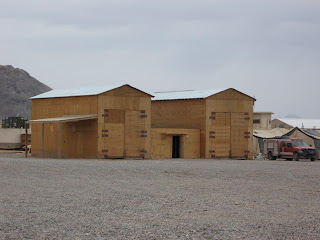(segments part 2)
The weekend started off great. I stacked all the rings Friday
night for final glue up. I got the clamps applied and walked away. Saturday, I
spent with my beautiful bride as we enjoyed the Broadway play, “Billy Elliot”.
Sunday was spent with church and friends and I had Monday off. So Monday
morning I walked out to the shop, released the clamps and mounted the project
to the lathe. As I rotated the spindle by hand, I noticed something. One side
was heavy. I rechecked the mount. It was centered. Then I looked a little
closer at the rings…
Call it fatigue, call it forgetfulness, or just bad luck.
Whatever one calls it, I did it! The problem with picking up a skill that was
once mastered and then forgotten is that one tends to remember the steps but
forgets the techniques that go with each step. I should have remembered that I
built a clamping jig for projects greater than six inches in diameter. But, I
did not ... until it was too late.
During the application of multiple bar clamps, 3 of the
rings slid out of position. This shift caused the stack to be lopsided. Had I
used the jig, singular pressure would have been applied on all points at once.
DOH!
What to do? This project was, from the beginning, a skill refresher.
During the ring build, I made a few mistakes but overcame them. What to do now?
If this was a commission piece or part of a production run, I would have set it
aside, possibly even tossed it into the burn pit. However, neither of those
scenarios applied. So far, about 33 hours has been invested. I decided to
continue, to see this project to the end. I think it can still be salvaged. If
not, I have learned and re-learned some useful techniques.
The lathe came to life. A noticeable wobble sound filled the
room and reverberated across my garage workshop. Quickly I began making light cuts until
the wobble slowly turned into the sound a something spinning true. A light hum
filled the room and washed out my tinnitus. Ribbons of wood peeled off and fell
to the floor. I stopped the machine
frequently (every 2 to 3 minutes) to check progress. One side was ready for
sanding, but the other side looked like it had not been touched. Although the
top and bottom rings were good all around.
When I started this, I planned each segment to be an inch
wide with a ¾ inch overlap. I wrestled with that as a lot of wood would be
wasted. Now it works to my advantage. I went back to the graph paper drawing.
In theory, this might just work. There should be enough wood overlapping to
offset the shift. There is another issue, the profile is changing. The angle
from the top to base is becoming steeper. As I stared at the project, the
thought of tossing it in the burn pit became more prevalent. Maybe I should
just start over.
As a sigh of disgust washed over me, I saw something out of
the corner of my eye. The project, still on the lathe, not as the bowl I had
designed, but as something different. The lathe came back to life as I picked
up my gouge and once again began peeling away the layers of wood. Shavings
piled at my feet, as their aromas filled the air. The original profile is all
but gone. A new purpose for this project is born. It will never be a show piece
as it is far from perfect and yet, as I look at it, I can already see more
character then many “perfect” pieces could ever have. Oh it is so very flawed.
But peel away a few layers, sand a few more, add a little polish, a little
buffing and maybe even a slight modification and I am betting it will shine.
People are a lot like that. You have perfect pieces that shine but have no
character. Then you have others that are full of flaws but just need a chance
to show how much character they really have!
This project continues. The piece is still on the lathe
waiting for my return. I have already drafted the plans for the modification.
With any luck, it will all get done this weekend!
Until then,
Kevin
P.S. I took several
pictures during this process and even shot a short video. As I went to download
everything this morning, I found the memory is empty! Only the two pictures I
uploaded to Facebook still exist. I am not sure what happened.

.jpg)















